

Jupiter will climb even higher in my skies this year compared to last. Jupiter reached its summer solstice in the northern hemisphere this year. Since the four major satellites revolve in Jupiter's equatorial plane, this means that shadow transits are near their furthest south, but Ganymede still produces very short transits and shadow transits near to the southern limb. Io and Europa continue to produce transits, but Callisto misses completely. You can see my pictures of a shadow transit of Callisto here.
For some images extra information is available if you move your mouse over the image.
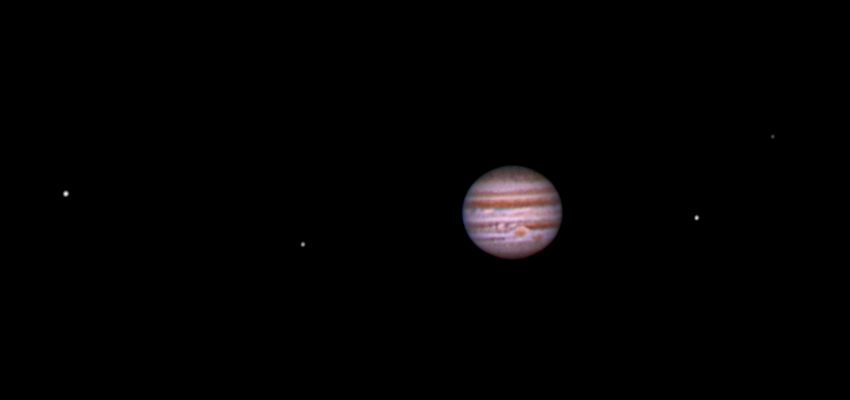
This is my first picture of the season. Jupiter was still quite remote at 700 million kilometres, subtending 48 arc-seconds. Unfortunately my computer failed recently and as a consequence I cannot use my DFK camera, so this image was taken with my trusted old ToUcam 840K. The image is a composite of three images, two for the satellites and one for the planet.
Date and Time: 18-19th November 2012, 23.48 and 00:18 UT
Camera: ToUcam 840K
Telescope: LX200 at prime focus
Capture: K3CCDTools. Satellites: 1/25", gain 0, 310 frames; Planet 1/100", gain 19%, 475 frames
Processing: Registax6. 1 alignment point, 150 frames stacked from each avi file. Gaussian wavelets Scheme 9, histogram stretched as appropriate.
And now some pictures of shadow transits of the three Galilean satellites that can cause them. All were taken at the prime focus of my LX200. The first set were taken using my ToUcam 840K, but by the time the other three were done I had my DFK camera back in action. I was lucky to get clear nights on these three critical days, although conditions deteriorated badly for the second half of the transit of Europa.
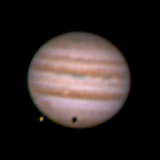 |
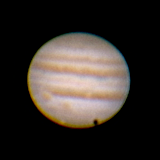 |
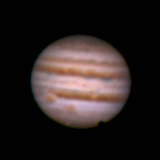 |
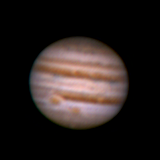 |
These pictures show the shadow transit of Ganymede between 1940 and 2048 UT on 21 November 2012. You can just make out Ganymede as it becomes silhouetted against the planet. Each captured with a ToUcam840, around 620 frames, 1/50 sec exposure and low gamma except for the one at 20:24 which was 1/100 sec and high gamma in order to resolve Ganymede at the cost of contrast in the cloud belts. Processed in RegiStax6, one alignment point, 150 frames, Gaussian wavelets Scheme 9, histogram stretched as appropriate. |
| Time: 19:40 | Time: 20:24 | Time: 20:31 | Time: 20:48 | |
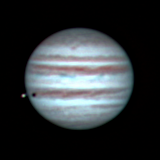 |
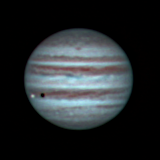 |
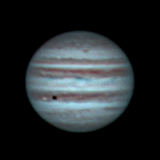 |
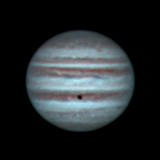 |
And now the shadow transit of Io between 0137 and 0234 UT on 24 November 2012. You can see that the transit occurred much further north than that of Ganymede, and I was lucky that it occurred against the dark southern equatorial belt. Io itself can be seen clearly to the left of the shadow. My DFK camera was back in action; each picture was taken with 1/27 sec exposure with gains around 700 and a low gamma. Processed in RegiStax6, one alignment point, 150 frames, Gaussian wavelets Scheme 9, histogram stretched as appropriate. |
| Time: 01:37 | Time: 01:49 | Time: 02:03 | Time: 02:34 | |
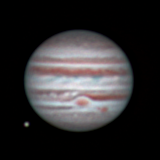 |
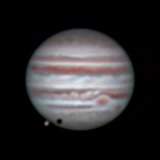 |
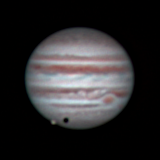 |
And now another, better, set of a shadow transit of Ganymede between 22:25 and midnight UT on 28 November 2012. As expected the transit is very near the southern limb of Jupiter, but you can clearly see the image of Ganymede silhouetted against the planet. Taken with my DFK camera at prime focus of my LX200; each picture was taken with 1/30 sec exposure with gains around 800 and a low gamma. Processed in RegiStax6, one alignment point, 150 frames, Gaussian wavelets Scheme 9, histogram stretched as appropriate. |
|
| Time: 22:25 | Time: 23:02 | Time: 23:16 | ||
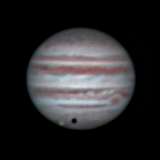 |
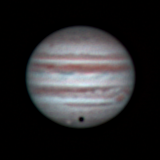 |
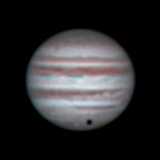 |
||
| Time: 23:30 | Time: 23:44 | Time: 24:00 | ||
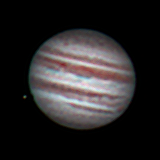 |
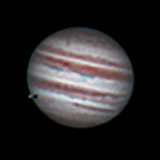 |
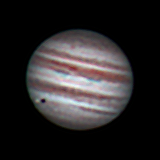 |
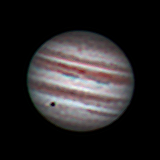 |
And now a shadow transit of Europa between 1952 and 2030 UT on 29 November 2012. Europa's orbit lies between those of Io and Ganymede, so the transit occurred further south than that of Io but north of that of Ganymede. I was able to follow the transit much further but the sky conditions were deteriorating with patchy cloud moving over and the pictures were not worth much. The pictures were taken with my DFK camera and 1/23 or 1/27 sec exposure with gains around 600 and a low gamma. Processed in RegiStax6, one alignment point, 150 frames, Gaussian wavelets Scheme 9, histogram stretched as appropriate and then the gamma reduced to 0.8. Finally I used Focus Magic at 4,100 to sharpen the pictures. |
| Time: 19:52 | Time: 20:01 | Time: 20:15 | Time: 20:30 | |
It is quite interesting to look at the separation of the shadow from the satellite in these images. Of course, seen from the Sun, the shadow would be right behind the satellite and so you would not see it. But in general the Earth is not on that line so we see the the shadow displaced from the satellite. However in the early hours of 3 December, Jupiter reached opposition, so at that time we would not have been able to see the shadows. (Actually the Earth was not exactly on the Sun-Jupiter line but the angle Sun-Jupiter-Earth was less than one degree, so I think I'd have been hard pressed to see the shadow, had there been one.) The actual separation of the shadow from the satellite will also depend on how far the satellite is from Jupiter, so, at any given time, the separation will be greatest for Ganymede and least for Io. My pictures of Europa were taken only 3 days before opposition, so the shadow is very close. My second set of pictures of Ganymede were taken the previous day, so 4 days before opposition; combined with the greater distance of Ganymede from Jupiter this results in a greater separation between satellite and shadow. Compare these pictures with the earlier ones, taken 11 days before opposition, when the separation was so great that the transit of Ganymede started only 46 minutes before the shadow transit ended. (The whole transit took almost 2 hours.) After opposition, the shadow will appear on the other side of the satellite; that is the shadow will appear to follow the satellite across the face of Jupiter. Of course, if you could be on Jupiter at the time and on the track of the shadow, you would see a total eclipse of the Sun.